Segment
Activity
Source
Year

Forecasting Green Jobs in Africa
5-year forecasts (to 2030) in 12 material value chains indicates there will be 1.5 to 3.3M new direct green jobs, driven by ambitions to scale energy generation and efforts to modernise agriculture
• Energy and power is expected to generate up to 2M jobs (70% of total), primarily from solar at up to 1.7M (57% of total) and power transmission and distribution at up to 197K (6% of total)
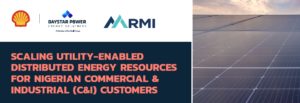
Scaling Utility-Enabled Distributed Energy Resources for Nigerian Commercial & Industrial (C&I) Customers
The proposed utility-enabled business model will leverage the reliability benefits of distributed power, such as solar and batteries, and the increased grid electricity consumption, to better serve C&I customers, replacing expensive diesel usage. This model requires no upfront capital investment from the customer. Daystar, as the developer, is responsible for securing financing and installing and operating the DER system on-site to provide power supply during daytime peak hours (9am to 3pm).
Report Rating : 4.5
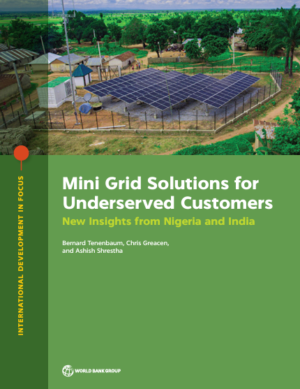
Mini Grid Solutions for Underserved Customers: New Insights from Nigeria and India
Mini-grids, powered by solar and batteries, are emerging as a vital solution for advancing rural electrification, particularly for the millions lacking access to modern energy. Once considered marginal, they are now at the forefront of a distributed energy resources paradigm shift. The World Bank’s Global Facility on Mini Grids has played a pioneering role in nurturing their growth, mobilizing private investment alongside development partners for isolated villages in Africa and Asia. These mini-grids offer two significant benefits: first-time access to reliable electricity and immediate reductions in harmful emissions by displacing polluting generators. However, their success hinges on affordability and commercial sustainability. A new trend, undergrid mini-grids, is emerging in low- and middle-income countries, particularly in areas connected to the main grid but with poor service supply. Firms are deploying undergrid solar hybrid mini-grids to address these challenges, exemplified by projects in India and Nigeria, aiming to enhance affordability and commercial viability through bulk purchases and sales.
Report Rating : 4.5
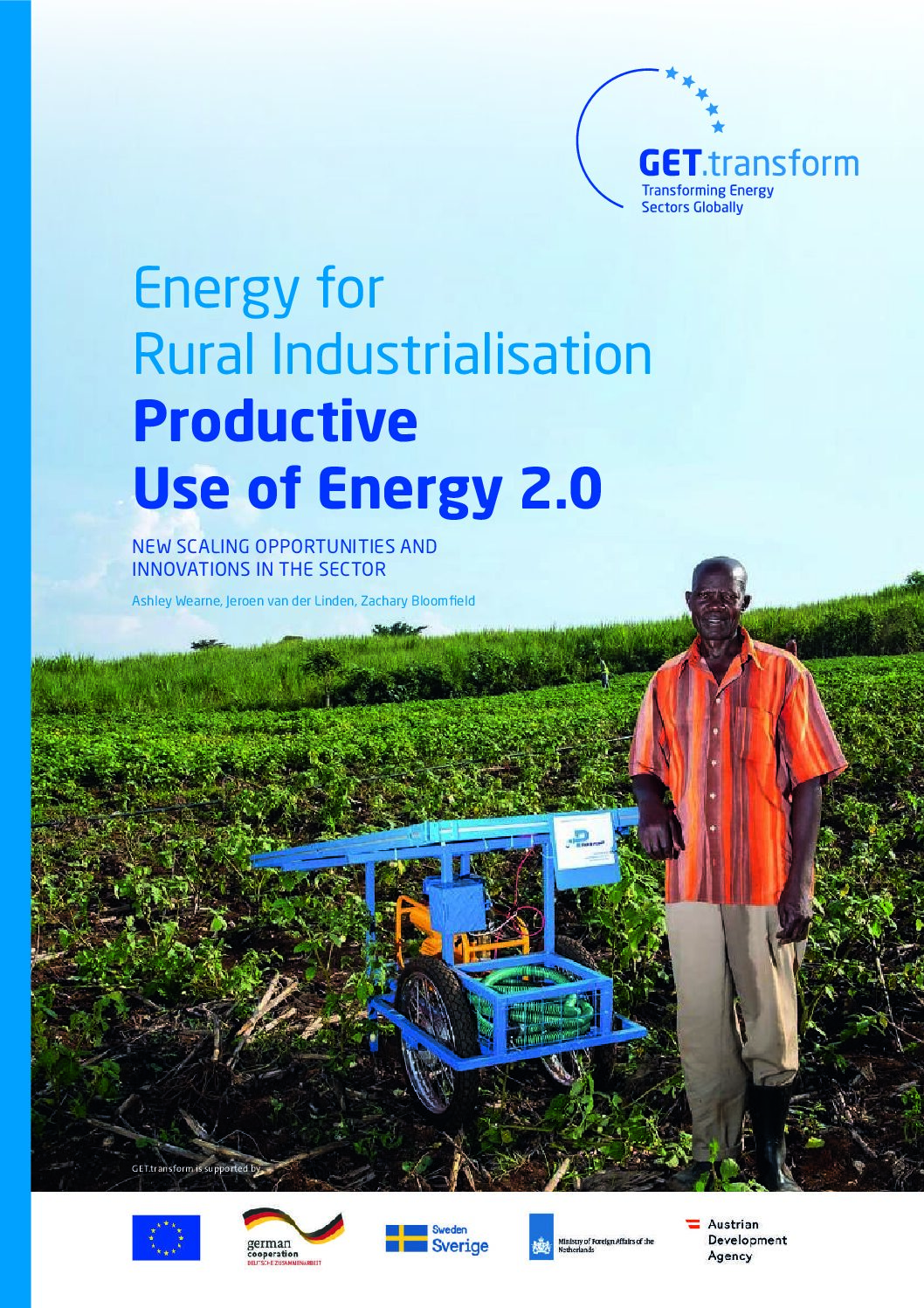
Energy for Rural Industrialisation Productive Use of Energy
Over the past decade, many pilot projects and village-level donor interventions have been conducted by development
agencies, programmes and research institutes like GIZ, EnDev and A2EI, on the productive use of (renewable) energy (PUE) in rural off- and on-grid electrification. The objectives of these projects have centred around enhancing the financial feasibility and economic impact of energy access. The feasibility and impact of the PUE measures themselves have also been examined. It is well established that PUE initiatives increase the socio-economic impact of electrification. PUE reduces workload, increases income and generates employment opportunities, along with other positive outcomes pursued under the heading of rural development. Experience also shows that the omission of a well-integrated PUE strategy can often minimise the intended impacts of rural electrification programmes in Africa.
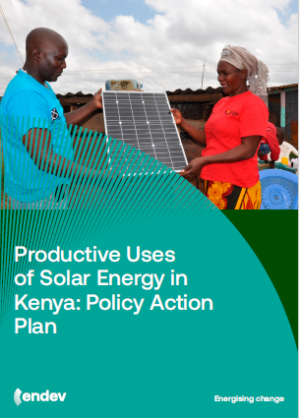
Productive Uses of Solar Energy in Kenya: Policy Action Plan
Kenya is a vibrant hub to more than 100 companies selling solar-powered appliances that are being used across the national economy to generate value and income. Productive Uses of Energy (PUE) is an umbrella term for various ways of using off-grid solar photovoltaic (PV) electricity to power electric appliances that help in running a business or an income-generating activity.
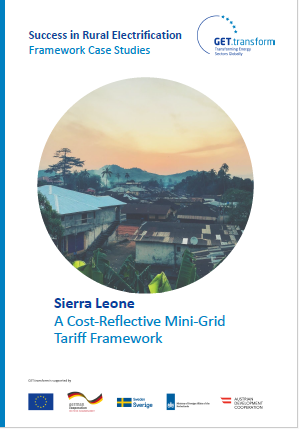
Success in Rural Electrification: Case Studies of Sierra Leone
The Government of Sierra Leone (GoSL) is prioritizing achieving universal electricity access by 2030, recognizing the scarcity of public resources due to past conflicts and recent health crises. To accelerate rural electrification, international private sector involvement is deemed essential, facilitated by partnerships with organizations like the UK’s FCDO, DFID, and UNOPS. The Rural Renewable Energy Project (RREP) employs split asset mini-grid delivery models to attract foreign investment, with distribution assets owned by the Ministry of Energy (MoE) and generation assets financed and owned by the private sector. To incentivize investment, the GoSL has established a regulatory framework allowing mini-grid operators to charge cost-reflective tariffs defined by the Mini-Grid Regulations (2019), which consider various operational costs and provide for compensation in case of grid extension to mini-grid sites, thereby reducing reliance on government and donor funding for rural electrification.
Report Rating : 5
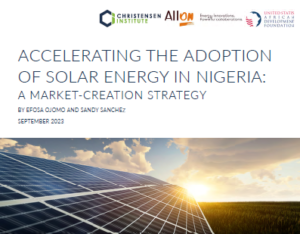
Accelerating the adoption of solar energy in Nigeria: A market-creation strategy
Nigeria, often referred to as the Giant of Africa, is a country of “largests.” It has the largest economy in Africa; it has the continent’s largest population; it is Africa’s largest oil exporter; and it has the largest percentage of immigrants with a university degree living in the United States.1 Unfortunately, Nigeria is also home to the largest number of people living in poverty in Africa and the world. In addition, the country has the largest energy deficit—the number of people living without electricity—globally. (See Figure 1 for some demographic information about Nigeria.)
Report Rating : 5
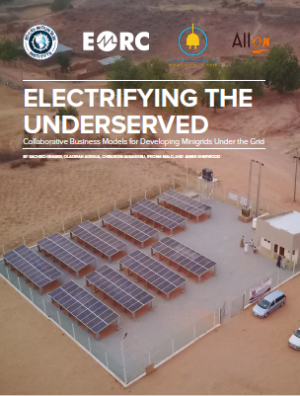
Electrifying the Underserved
In Nigeria, thousands of communities face unreliable or nonexistent electricity from distribution companies (DisCos). However, undergrid mini grids, and self-contained electricity systems up to 1 megawatt in size, present a significant opportunity to provide reliable and high-quality service to these underserved areas. Leveraging existing distribution infrastructure, undergrid minigrids offer lower system costs compared to isolated minigrids while improving service reliability. These systems not only help DisCos reduce losses and create a lucrative mini-grid market but also save customers significant expenses annually. For communities already served by DisCos but struggling with unreliable power, mini-grids offer transformative access to reliable electricity, fostering local development through distributed energy resources. Rural and peri-urban areas with low reliability and promising load profiles emerge as prime candidates for commercial undergrid mini-grid projects.
Report Rating : 3
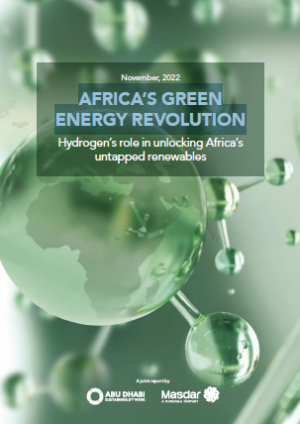
Hydrogen’s role in unlocking Africa’s untapped renewables
Hydrogen is increasingly recognized as a critical element in the global transition towards net-zero emissions, particularly due to its role in decarbonizing hard-to-abate sectors and addressing energy security concerns amid global conflicts. Its potential extends to accelerating socio-economic development in regions like Africa. Green hydrogen, derived from renewable sources, serves to decarbonize various industries such as ammonia production, refining, maritime and aviation propulsion, steelmaking, and heavy-duty trucking. As an energy carrier, hydrogen enables the storage and long-distance transportation of clean energy, facilitating its distribution from resource-abundant regions to areas with high demand. Governments worldwide support hydrogen initiatives, with numerous strategies and incentives in place. The private sector is also heavily investing in hydrogen projects, anticipating a significant increase in demand by 2050 as countries strive to achieve their net-zero commitments.
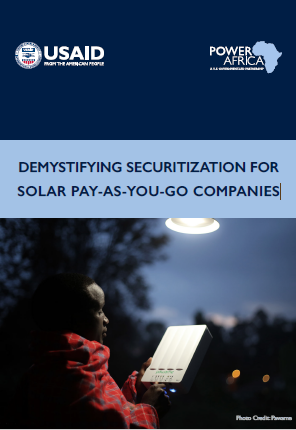
Demystifying Securitization for Solar Pay-As-You-Go Companies
This paper aims to demystify off-balance-sheet (OBS) securitization for pay-as-you-go (PAYGO) companies
working in sub-Saharan Africa (SSA). Its approach is to pose and answer questions that PAYGO companies
would have in mind as they consider embarking on securitization. Investors stand to benefit from this paper
as much as off-grid companies. It outlines the factors that PAYGO companies evaluate as they consider OBS
financing, and informs investors how they can become more involved in OBS securitization. With this paper,
we encourage off-grid companies to see how OBS facilities can help them grow and expand energy access in
Africa. For sharing their experience in OBS financing, we thank Africa Frontier Capital, BBOXX Group, the
Development Finance Corporation (DFC), D.light, NeoT Capital, and PaygOps.
Report Rating : 4.8
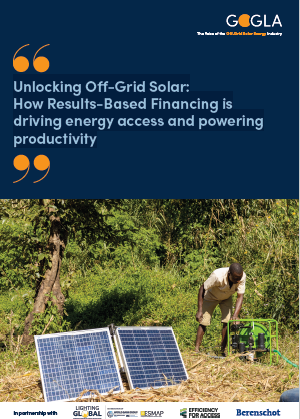
Unlocking Off-Grid Solar: How results-based financing is driving energy access and powering productivity
Results-Based Financing (RBF) schemes are a powerful tool, enabling governments and development partners to leverage the private sector to achieve development goals. Over the last decade, RBF programmes have been piloted, scaled and diversified within the energy access sector, aimed at reaching the 675 million people who lack access to modern electricity today. In parallel, annual sales of off-grid solar products have more than doubled GOGLA affiliates, which make up nearly 30% of the off-grid solar market, have sold over 70 million solar lanterns and solar home systems (SHS) since 2012. Alongside them, they have sold millions of appliances for both household and productive use.
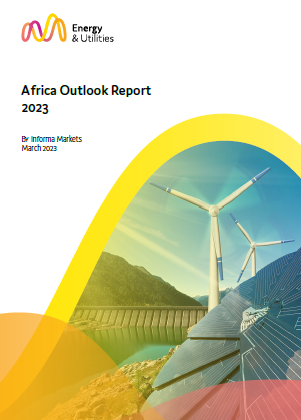
Africa Outlook Report 2023
Sub-Saharan Africa, with a population of approximately 1.3 billion, represents about one-fifth of the global population but consumes only 3% of the world’s electricity. Despite this, innovative entrepreneurship and a growing array of energy sources are gradually overcoming the challenges posed by the region’s outdated infrastructure. Off-grid solar power is expected to play a significant role in providing electricity to new connections in the foreseeable future. While only a few African countries have achieved full electricity access, such as Egypt and Tunisia, others, including Mauritius, Cabo Verde, and Gabon, have made significant progress. Larger economies like South Africa and Ghana still face challenges in providing universal electricity access, with power cuts remaining a prominent issue, particularly in South Africa, where it has become a significant political concern.
Report Rating : 4.66
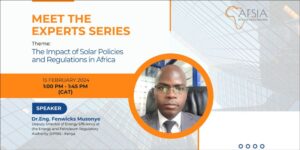
The Impact of Solar Policies and Regulations in Africa
Solar energy has emerged as a pivotal player in the global transition towards sustainable and renewable energy sources. To foster the widespread adoption of solar technologies in Africa, governments and regulatory bodies have implemented Solar Policies and Regulations.
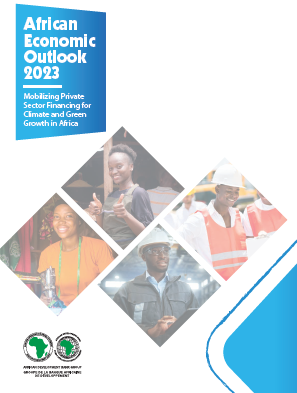
African Economic Outlook 2023
Africa’s real gross domestic product (GDP) experienced a growth rate of 3.8% in 2022, slightly lower than the previous year’s 4.8% but still above the global average of 3.4%. This slowdown was primarily attributed to tightening global financial conditions and supply chain disruptions intensified by the Russia-Ukraine conflict, which subdued global growth. However, growth is expected to rebound to 4% in 2023 and further consolidate at 4.3% in 2024, reflecting Africa’s continued resilience to economic shocks.
Report Rating : 1
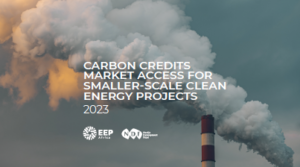
Carbon Credits Market Access for Smaller-Scale Clean Energy Projects
In recent years, there has been remarkable growth in the demand for carbon credits from Africa, surpassing global growth rates in this sector. Despite the region’s strong potential, accounting for about 11% of global carbon credit issuance but tapping into only 2% of its maximum potential, efforts are underway to unlock this untapped market. Notably, just five countries contribute to around 65% of the total issued credits, with Kenya leading at 23%. However, the market displays fragmentation, with a limited number of project developers mainly focusing on forestry and land use, renewable energy, and household devices, which collectively account for roughly 97% of issued carbon credits.
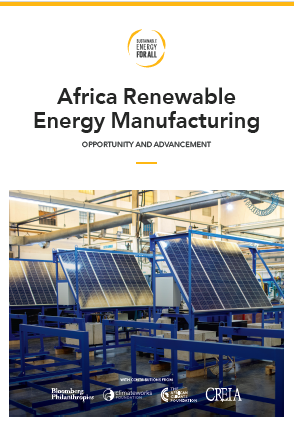
Africa Renewable Energy Manufacturing
Renewables are expected to play a central role in Africa’s power sector development, with capacity expected to grow to 180 GW by 2030 and 1.2 TW by 20504. This growth in renewables presents a significant opportunity for the continent to accelerate its overall economic growth, develop new local value chains, reduce the trade deficit,
and create between 8 million and 14 million good-quality jobs. As Africa’s main trade partner and the leading country in renewables manufacturing, China could be a strong partner for African countries as they develop
local manufacturing capabilities.
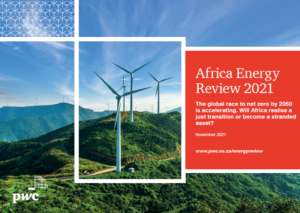
Africa Energy Review 2021
It has been estimated that achieving global net zero by 2025 0n will cost $130bn making it the single biggest global growth opportunity. For those who don’t transition, it will be a significant disrupter with the risk of major stranded assets across the globe. A critical question yet to be answered is whether Africa will benefit from an equitable store in global investment and growth or, lack the economic strength will continue to fall further behind global standards as outlined in the Sustainable Development Goals (SDGs).
While Africa’s energy sector is vital to the continent’s economic prospects, it has not been able to achieve the reliable domestic energy supply that the people and businesses require. Energy demand in Africa has been increasing at an annual rate of around 3%, the highest among all continents, but energy supply continues to lag significantly.
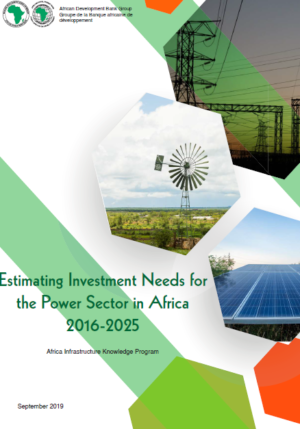
Estimating Investment Needs for the Power Sector in Africa 2016 - 2025
How much investment is needed to realize the African Development Bank´s (AfDB) New Deal on Energy for Africa (the New Deal)? This is the overriding question that is thoroughly analyzed from the bottom-up for 54 countries in Africa, covering generation, inter-connectors, transmission and distribution (T&D), mini-grids and off-grid access options. Underlying the analysis is an unprecedented collection of data, high-resolution regional power investment optimization and a tailor-made access expansion model for the continent. The answer to this question is an average annual investment of 29-39 billion USD until 2025, depending on the continent’s ambition as to avoided greenhouse gas (GHG) emissions. In total, 230-310 billion USD is required until 2025, while an additional 190-215 billion USD is required for the period 2026-2030. The total average annual investment from 2018 to 2030 is estimated at 32-40 billion USD, as depicted in the figure below.
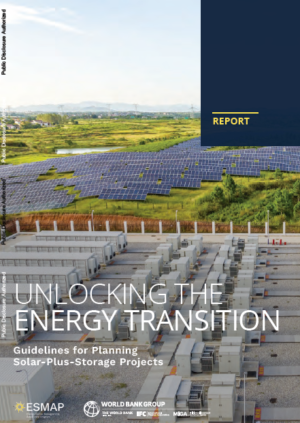
Unlocking the Energy Transition
Developing countries face challenges related to energy imports, volatile prices, and fuel dependency, often leading to fiscal crises due to expensive thermal generators. Integrating renewable energy with storage systems offers a cost-effective solution, enhancing grid flexibility and reducing reliance on fuel-based generation. Private investment, facilitated by long-term power purchase agreements with independent producers, plays a crucial role. While still a small portion of the market, solar-plus-storage projects are growing rapidly, providing opportunities for developing countries to unlock private capital and reduce dependence on public funding, particularly focusing on utility-scale implementations.
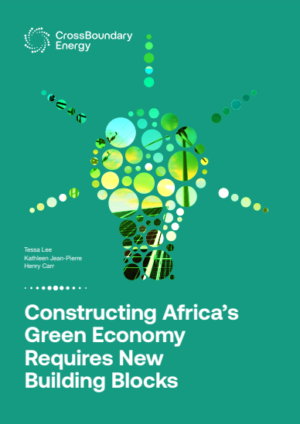
CrossBoundary Energy - DER -Regulatory-Building-Blocks
African regulators face an exciting opportunity: the chance to leapfrog legacy energy market structures and accelerate the integration of distributed energy resources. In doing so, they can boost grid integrity, create
green jobs, and define a new and cleaner path to industrialization.
This White Paper hopes to break this trend by providing concrete guidance to policymakers, regulators, and energy sector officials on which policy building blocks should be selected and deployed at different stages of electricity market evolution. Maximizing the benefits while controlling the risks of DER integration, rests on using the right tool for the problem and doing so at the right time.
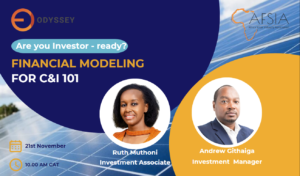
Financial Modeling for C&I
Financial modeling is a critical aspect of any commercial and industrial (C&I) solar project.
If you are a solar developer seeking investment for one or multiple projects, understanding the key components financiers are looking for in C&I financial models is essential.
Odyssey Energy Solutions aims to provide a comprehensive overview of financial modeling for C&I, covering the essential elements financiers seek, common mistakes developers make when approaching investors, the various types of capital available for C&I projects, and free tools available to create financial models.
Report Rating : 4.4
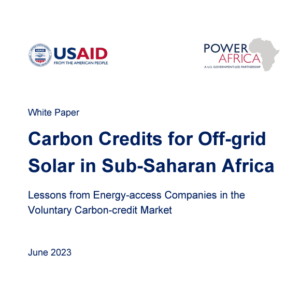
Carbon Credits for Off-grid Solar in Sub-Saharan Africa
Lessons from Energy-access Companies in the Voluntary Carbon-credit Market
Power Africa is a collaborative initiative led by the United States Government in conjunction with African governments, privatesector organizations, and multilateral institutions. Power Africa’s goal is to increase electricity access by adding 30 megawatts of new generation capacity, and 60 million new connections through on- and off-grid solutions by 2030. Power Africa defines energy “access” as the number of new households and businesses connected to electricity through an on- or off-grid power source. This paper offers insights for off-grid solar companies keen to explore the voluntary carbon market. The paper builds on the technical assistance with carbon credits that Power Africa and CarbonClear provided to two off-grid companies.
This resource also draws on CarbonClear’s experience of working with more 20 solar companies to evaluate the opportunity and risks of implementing a carbon-credit program. By focusing on sub-Saharan Africa, this paper examines some of the obstacles that solar companies face and explores effective carbon-credit strategies to navigate this market successfully. The voluntary carbon market (VCM) is an evolving mechanism that enables an entity to offset its greenhouse-gas emissions by purchasing carbon credits from emission-reducing projects. Although Africa holds significant potential for climate finance and sustainable development, it currently composes only a small portion of the global VCM.
One initiative to expand Africa’s share of the carboncredit market is the Africa Carbon Markets Initiative. Launched in 2022, the Africa Carbon Markets Initiative aims dramatically to scale voluntary carbon markets across Africa by producing 300 million credits annually by 2030, unlocking $6 billion in income, and supporting 30 million jobs.1
Download here
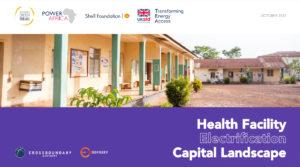
Solar for healthcare
The material provided herein is for informational purposes only. It does not constitute an offer to sell or a solicitation of an offer to buy securities relating to any of the entities referenced herein, notwithstanding that any such securities may be offered in the future.
Nothing contained in the information regarding the entities referenced in this presentation constitutes investment advice. CrossBoundary is providing the information contained herein for your review and consideration as part of its broader mandate to enable the transparent exchange of information across the markets it serves. In exchange for receiving this presentation, you agree to hold CrossBoundary and its affiliates, agents and representatives harmless from and against any claims whatsoever and of any nature for damages that may arise from or relate to any decision that you make based on this information.
Information on the entities referenced in this presentation is based solely from, and in reliance on, a combination of i) information sourced from reliable providers of market data, ii) CrossBoundary’s own analysis and iii) information provided by the entities directly to CrossBoundary and is provided “as is” without warranties of any kind.
The views expressed in this report do not necessarily reflect the views of the broader market,or any other entity referenced herein. While every effort has been made to ensure that the data quoted and used for the research
behind this document is reliable, there is no guarantee that it is correct, and CrossBoundary can accept no liability whatsoever in respect of any errors or omissions.
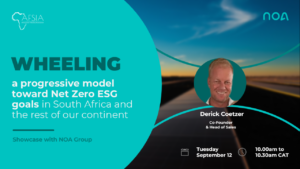
Showcase - Wheeling - a progressive model toward Net Zero ESG goals in South Africa and the rest of our continent
Showcase: Wheeling – a progressive model toward Net Zero ESG goals in South Africa and the rest of our continent, was an exclusive event that explored how the concept of wheeling contributes to achieving Net Zero emissions and Environmental, Social, and Governance goals.
The event took place on September 12th, 2023, from 10:00 am to 10:30 am.
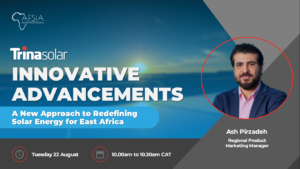
Showcase - A New Approach to Redefining Solar Energy for East Africa
Showcase with Trina Sola, an event hosted by AFSIA (Africa Solar Industry Association) under the theme ”A New Approach to Redefining Solar Energy for East Africa” with Ash Pirzadeh.
The event explored the latest advancements and innovations in solar energy solutions tailored for the East African market and took place on August 22nd, 2023, from 10:00 am to 10:30 am.
Download the presentation Here
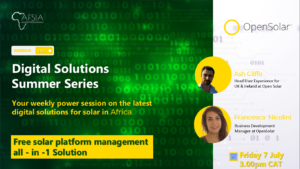
Digital Solution Summer Series
Are you ready to drive into the world of digital solutions and unlock the potential for your business? We are thrilled to announce our Digital Solution Summer Series event happening each Friday over the course of 2 months.
With the rapid advancement of technology, businesses across industries are embracing digital solutions to stay competitive and thrive in the digital age. This series is designed to provide you with valuable insights, practical knowledge, and actionable strategies to drive success.
Join AFSIA each Friday to hear the cutting-edge technologies showcases with witnesses of the latest digital solutions in action and learn how they can revolutionize your industry.
You will hear from industry leaders and subject matter experts who will share their experiences, best practices, and insider tips on implementing successful digital solutions.
- OpenSolar showcasing free solar platform management all – in -1 Solution by
- Francesca Nicoline, the Business Development Manager and,
- Ash Cliffe Head User Experience for UK & Ireland
Mark your calendars now and stay tuned!!!
Download the fist Session Here
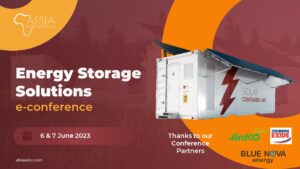
Energy Storage Solutions e-Conference 2023
Solar energy and storage are growingly interlinked in the African context. Thanks to technological improvements and a sharp reduction in prices, the combination of both solutions are now getting more and more interest from individuals and companies looking for cheap and reliable electricity throughout the continent.
Energy storage solutions are evolving fast and it is sometimes difficult to keep track with all latest developments in this exciting industry. This e-conference aims at bringing together the best experts of the industry to provide a full overview of the latest updates on energy storage. It will also offer an opportunity to showcase their most innovative solutions and projects, so stakeholders from all over Africa will learn what solutions are available and deliver results, even in the most demanding environments.
During this webinar, We had the pleasure to welcome our distinguished
Event Partners:
Titus Koech – Technical Service Manager at Jinko Solar
Sammy Waite – BD Manager at Chloride Exide
Anré Swart – Business Development Exec – BlueNova
Carl Kies – Chief Technical Officer – BlueNova
Event Speakers:
Nuno Gomes – Vice President of ASAER
Moeketsi Thobela – Chief RE Investment Specialist at African Development Bank Group
Julia WANG – CEO of Seetek Power
Erik Nygard – Founder & CEO of Kofa
jean-philippe SEYA – Senior Project Development Manager at CrossBoundary
M Jibril Omar – CEO of OFGEN
Elena García Ortiz – Project Manager at UL Solutions
Gilles Parmentier – CEO of Africa REN
Mawufemo Modjinou, Ph.D. – Project Coordinator at WAPP
Shane Marcelo Prins – Generation Development and Municipal Energy Efficiency Manager- City of Cape Town
Hiten Parmar – Strategic Advisor at South Africa Energy Storage Association(SAESA)
Mark Wopicho – Chief Technical Officer – Empower New Energy
Download Here
Report Rating : 5
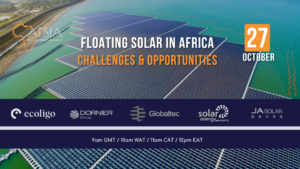
Floating Solar in Africa: Challenges & Opportunities
Floating solar has always been a subject of curiosity and also a source of hope for countries and islands with limited land. This technology is evolving fast and research is being done to assess its potential in Africa. Finding an ideal location for water to meet the sun and create a strong source of energy without affecting the space are the promises of floating solar among others: higher energy yield, reduction of the evaporation of the water plant and improvement of water quality.
Floating solar photovoltaic technologies are opening new opportunities for scaling up solar generation capacity in Africa.
During this webinar, We had the pleasure to welcome our distinguished guests:
- Raúl Granados – Head of Renewable Energy Resources at Dornier Suntrace as moderator
- Paul Kotze – Founder & Managing Director of Solar Energy Architects
- Sergio Montoro Castillo – Head of Renewable Energy at Globaltec
- Henry Ejinwa – Sales Manager West & Central Africa at JA Solar
- Susan Kiarie – Country Manager, Kenya at ecoligo
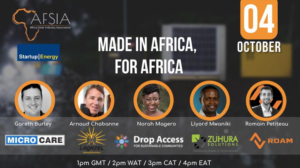
Africa Energy Start-Ups Series: Made in Africa, for Africa
The “Africa Energy Start-Ups Series” is a collaboration between AFSIA and Start-Up | Energy which features innovative African start-ups every 2 months on a multitude of topics such as e-mobility, storage, fintech and productive use to cite a few. The spirit of this series is to promote African start-ups, for Africans by Africans and to present how innovative they are to potential partners and investors coming from the rest of the world.
This time we are thrilled to show that the African continent has huge resources to manufacture qualitative equipment locally. Solar components “Made in Africa” are way less known than their imported competitors. In the political context that we all know, there is a new incentive to produce locally and not depend on expensive imports. This new parameter has several implications. Of course economical but also from a building capacity, local content and many other perspectives.
During this webinar, we are asking several start-ups to showcase their “Made in Africa” equipment and have the opportunity to highlight their competences with solar panels, solar kits, batteries, and inverters to name a few.
We will have the pleasure to welcome our distinguished guests from:
- Gareth Burley, Sales & Marketing Manager, Microcare
- Arnaud Chabanne, Head, Lagazel
- Norah Magero, Founder, DropAccess
- Romain Petiteau, Head of Energy & Charging Systems, Roam
- Llyord Mwaniki Gitau, Co – Founder, Product Development, Zuhura Solutions
Report Rating : 5
War in Ukraine and COVID aftermath: Uncertainties and opportunities in the solar industry market in Africa
As the world is still trying to recover from the pandemic, another threat emerged coming from Eastern Europe and affecting the entire world. The war in Ukraine combined with the consequences of COVID19 are impacting strongly the logistic chain, raw materials costs and expenditures, legal contracts, deliveries schedules among others.
All players being big or small need to work on solutions and constantly adapt to the geo politique and sanitary situation.
In this webinar, we will try to understand how the solar industry players are impacted and how they can overcome the uncertainty of this period.
We will also try to see if the solar industry will be deeply changed and reinforced by the need for energy autonomy from different states.
We will have the pleasure to welcome our distinguished guests:
- Gurmeet Kaur – from Pinsent Masons to moderate
- Emeka Wosu – from LONGi
- Paul Dupreez – Sales Manager from SegenSolar
- SNYDERS Rina – Business Development Manager from Advanced Maritime Transport
- Tang Wen, – Logistics Senior Manager (Europe, Middle East & Africa)from LONGi
- Michael Lappin – Sales and Operation Manager from SegenSolar
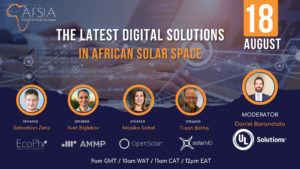
The latest digital solutions in African solar space
From conception to implementation, from financial structuration to monitoring and maintenance, digital solutions are supporting players of the industry at each stage of a solar project.
Automation through a digital system allows for more flexibility and hence scaling up energy access. Being able to monitor a project on a single platform or anticipate a challenge can benefit the entire value chain.
In this webinar we will:
- Discuss and present the latest innovations in the sector but also explore the benefits and the challenges that a user can face.
- Discuss the financial implication of it: how the flexibility to structure a deal or to manage the operation can at the end, reduce costs.
Is digital solution more suitable for large scale solar projects or C&I? Is there a risk of hacking and are the systems strong enough to avoid this?
We will have the pleasure to welcome our distinguished guests:
- Daniel Barandalla – solar advisor lead Europe and Latin America from UL
- Sebastian Zenz – Founder from Ecophi
- Svet Bajlekov – CEO from AMMP
- Maaike Gobel – Head of Partnership from OpenSolar
- Tiaan Botha – Product Manager from Solar MD
Report Rating : 5
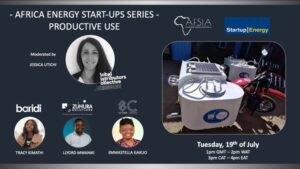
Africa Energy Start-Ups Series: Productive Use
The “Africa Energy Start-Ups Series” is a collaboration between AFSIA and Start-Up | Energy which features innovative African start-ups every 2 months on a multitude of topics such as e-mobility, storage, fintech, and productive use to cite a few. The spirit of this series is to promote African start-ups, for Africans by Africans and to present how innovative they are to potential partners and investors coming from the rest of the world.
This 3rd event of the series will focus on PUE (productive use of electricity) applications. PUE is a global term for all solutions that are enabled thanks to solar electricity and allow for a revenue-generating use of solar energy. Popular PUE is solar-powered irrigation and pumping systems, egg incubators, and fishing lights to name a few.
In this webinar, we will put the spotlight on some less-known PUE applications which are:
- Solar cold rooms for meat
- Solar-powered milk-chilling transport systems
- Solar-powered street food carts
Report Rating : 3
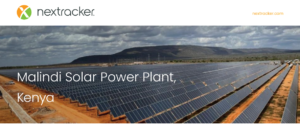
The Malindi Solar Power Plant Case Study
The Malindi Solar utility-scale PV project in Kenya provides another example of Nextracker’s project management and product technology excellence in challenging emerging markets.
Project Overview
Located on the coast of Kenya, the 52 MWp Malindi Solar plant is one of the largest utility solar farms in East Africa. The project was developed by Malindi Solar Group Ltd (MSG), which is owned by Globeleq (90%), an African independent power producer (IPP), and its partner AEDC (10%). Project financing was provided by BII (formerly CDC Group) and DEG, the development finance institutions of the UK and Germany, respectively. Sterling and Wilson was contracted by MSG to perform the engineering, procurement and construction work for the project. Construction on the project began in 2019 and was completed in 2021. The plant has been generating clean electricity since mid-December 2021 and selling it to national utility Kenya Power and Lighting Company (KPLC) under the terms of a long-term power purchase agreement. The project also included the construction of the new 220 kV Weru substation, which is now part of KPLC’s national grid infrastructure.
Nextracker was chosen for the Malindi Solar project because of its world-leading solar tracker technology and proven track record of on-time delivery, engineering and project management expertise, and comprehensive global services organization.
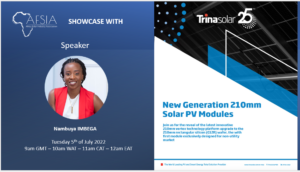
New Generation 210mm solar PV modules
Join us for the reveal of the latest innovative upgrade to the 210mm Vertex Technology Platform with 210mm rectangular silicon (G12R) wafer.
It has been noticed that some solar installers and developers have a habit of opting for low standard modules, sometimes with less guarantee and this in the objective to save on investments. In this context, Trina Solar technology innovation now makes it possible to get highest efficiency modules with a better control over costs, production, and storage capacity.
Join us during this presentation made by Nambuya Imbega, the sales manager at Trina solar. She will share all interesting insights about this new technology which can combine high efficiency and lower the cost of the installation.
This event is open to all and will be of particular interest to mini-grid and C&I developers along with installers active on the African market.
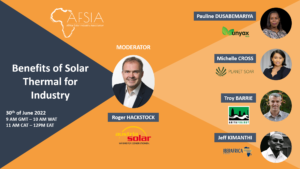
The benefits of solar thermal technology for industrial and residential use in Africa
It is estimated that 49% of the entire energy consumption globally is used for producing heat. But 75% of this heat is produced through burning fossil fuels.
Solar energy, when harvested through solar thermal technology (as opposed to the more famous solar photovoltaic), offers a compelling solution to address this need for heat while at the same time significantly reducing gas emissions.
Solar thermal technologies are not always well known. Very often people think this technology is limited to large CSP plants (concentrated solar power) in the north and south Africa. But industrial companies, as well as individuals, can also greatly benefit from solar thermal technologies.
In this webinar we will:
- Discover how an individual houses can greatly save on their electricity bills by replacing electric water heaters with solar water heaters
- Hear about the reasons why Iberafrica in Kenya decided to switch to solar thermal technologies and how it helps the company improve its operations and reduce OPEX
- Understand the motivation of an international investor to build a solar thermal technology manufacturing plant in Botswana
- Explain to listeners how they can benefit from solar thermal technologies, either directly at their homes or for their industrial activities
During this webinar you will get great insights from the following panelists:
- Michelle Cross – Head of International Business Development at Planet SOAR
- Pauline Dusabemariya – Coordinator at Munyax Eco
- Troy Barrie – CTO at Ariya Finergy
- Jeff Kimanthi – technical office Manager at Iberafrica

Optimizing Performance in new utility and Commercial & Industrial Solar Pv projects in Africa for Enhanced profitability
Optimization of solar PV plants’ output plays an essential role in not only making “solar cheap” but also ensuring its long and durable life — increasing dependability on the intermittent sunlight.
Intelligent control strategies and optimization methods are utilized in solar energy systems.
Optimizations strategies reduce emissions and costs of system into maximizing reliability. Solar energy systems enhance the output power and minimize the interruptions in the connected load.
In this webinar we will:
- discuss how optimized PV modules will be breakthrough to enhancing your utility and C&I solar investment
- discuss about the increased reliability that allowed it provide direction to the PV industry
- Discover how optimizing performance in new utility and C&I solar PV project enhance profitability in Africa
During this webinar you will get great insights from the following panelists:
- Titus Koech – Technical Services- SSA at Jinko
- Jibril Omar – CEO at OFGEN
- Max Spannagel – COO at EcoPhi
Report Rating : 4.33
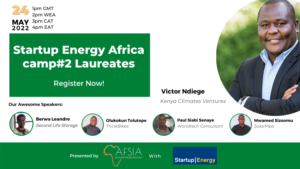
Startup Energy Africa Camp #2 Laureates
In March 2022, AFSIA partnered with Startup|Energy once again for the 2nd edition of the African leg of Startup|Energy.
Startup|Energy promotes the development of startups in the field of decentralized renewable energy supply and supports their exchange with each other across two regions:
- DA-CH: Germany, Austria, Switzerland
- East African Community: Burundi, Kenya, Rwanda, South Sudan, Tanzania, Uganda.
Startup|Energy is not about the one-sided transfer of knowledge but about an equal exchange of ideas and solutions for the respective region.
The 2nd edition of the Africa Boot Camp and pitch competition took place in April 2022.
In this session, the 5 shortlisted startups that will be presenting their initiative include:
- Victor Ndiege– CEO, Kenya Climates Ventures
- Olukakun Tolutope – CEO, ThinkBikes
- Berwa Leandre– Co-Founder, Second Life Storage
- Paul Siabi Senaye– Founder, WorldTech Consultant
- Mwamed Mutanje– Co-Founder, Solar Pipo
The “Africa Energy Start-Ups Series” is a collaboration between AFSIA and Start-Up | Energy which will present innovative African start-ups every 2 months on a multitude of topics such as e-mobility, storage, fintech and productive use to cite a few. The spirit of this series is to promote African start-ups, for Africans by Africans and to present how innovative they are to potential partners and investors coming from the rest of the world.
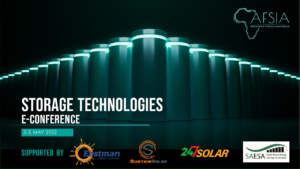
AFSIA e-conference Storage 2022
Solar energy and storage are growingly interlinked in the African context. Thanks to technological improvements and a sharp reduction in prices, the combination of both solutions are now getting more and more interest from individuals and companies looking for cheap and reliable electricity throughout the continent.
Energy storage solutions are evolving fast and it is sometimes difficult to keep track with all latest developments in this exciting industry. This e-conference aims at bringing together the best experts of the industry to provide a full overview of the latest updates on energy storage. It will also offer an opportunity to showcase their most innovative solutions and projects, so stakeholders from all over Africa will learn what solutions are available and deliver results, even in the most demanding environments.
Storage solutions come in many different shapes and applications. A lot of focus has been put on lithium technology in recent years, but the storage industry encompasses much more than lithium, each technology with its pros and cons depending on the specific situation and the specific end-user need.
AFSIA’s most recent e-conference attracted more than 2,000 registrants from Africa and the world. This virtual event is expected to be similarly successful as many individuals and companies across the continent are eager to increase their knowledge about the most recent possibilities of storage, about how it can help them in their day-to-day lives and discover who are the leading companies providing these solutions.
Key Considerations for a high efficiency product performance for your PV System
Now more than ever, system efficiency and return on investment of solar projects have become critical to a successful solar journey.
Solar modules contribute greatly in to the overall solar system efficiency and with the multitude of innovations brought to the market in the past 24 months, it is sometimes challenging to stay up-to-date and understand which aspects to take into consideration when planning your solar project. In this AFSIA Showcase, you will hear directly from LONGi’s Technical Support Specialist, Kevin Robinson to learn more about how the companies’ range of high efficiency products create increased value for your projects.
This session will be of particular interest to: – individuals and companies planning to go solar – EPC companies looking to stay up-to-date about the latest technologies – project financiers eager to identify how to increase their investments ROI
Report Rating : 4
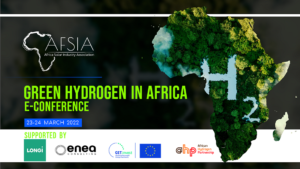
AFSIA Green Hydrogen in Africa e-conference
Hydrogen has already been used in industrial applications for many years, but there is now an opportunity to produce this hydrogen with very-low or totally carbon-free energy sources thanks to solar and wind energy. Thanks to cheap renewable energy, experts forecast the cost of hydrogen production falling from $6/kg in 2015 to around $2/kg by 2025.
As a result, green hydrogen has become the hot topic for industrial activity and decarbonization around the globe.
Some African countries are ideally positioned to take part in the global race to produce the cheapest green hydrogen. Several landmark projects have already been announced and started across the continent. Moreover, Africa is in a special position where it could benefit twice from green hydrogen: on one hand it could become a major global production hub for export, and the other hand green hydrogen could also be used for local production of green ammonia and green fertilizers which the continent is currently importing in mass quantities.
This year’s e-conference attracted more than 2,500 participants, eager to hear about the latest technology, project updates and the players who are positioning on this very promising industry.
The GCC could require grid-related investments of US$50 billion to accommodate renewable energy capacity, says Middle East Energy report
Dubai, UAE – 23 February 2022: The GCC could require nearly US$50 billion of grid-related investments to support proposed capacity additions from renewables, according to Clean Energy – Going Beyond the Grid, a whitepaper prepared by Frost & Sullivan for Middle East Energy, the MENA region’s most reputable and comprehensive event for the energy sector.
The whitepaper revealed that for the GCC to diversify its power mix, investment in large-scale renewables capacity additions is required and would need corresponding increased investment in transmission and distribution networks to eliminate inadequacies.
Middle East Energy to return to Dubai as a live, in-person event in March 2022
Dubai, UAE – 12 January 2022: Middle East Energy Dubai, the most reputable and comprehensive energy event in the MENA region, has confirmed registration is now open for the live and in-person event, which returns to the Dubai World Trade Centre from 7 – 9 March, under the theme of guiding you through the energy transition.
Africa Energy Start-ups series : Fintech
Financial technology (Fintech) is used to describe new tech that seeks to improve and automate the delivery and use of financial services. At its core, fintech is utilized to help companies, business owners and consumers better manage their financial operations, processes, and lives by utilizing specialized software and algorithms that are used on computers and, increasingly, smartphones. Fintech, the word, is a combination of “financial technology”.
In this webinar we will:
- Discuss how fintech allows last-mile distributors to connect with independent field operators, retailers, distributors & financiers, including pushing all project finance deals to investors, getting paid at the point of sale and improving the business liquidity.
- Find out how fintech solutions enable efficient solar micro-grid eco-systems to be deployed across Africa.
- Know how technology-backed aggregator companies offers innovative off-grid ‘energy as a service’ (EaaS) payment solution at scale and speed thanks to fintech
- Discuss about the financial inclusion by providing access to the millions of underbanked and unbanked in both rural and peri urban areas.
During this webinar you will get great insights from the following panelists:
Edmund Higenbottam – Managing Director at Verdant Capital
Adebola Sanni – Director at Infibranches
David Opio – CEO at GnuGrid CRB
Mobola Atoloye – Managing Director at OneWattsolar
The “Africa Energy Start-Ups Series” is a collaboration between AFSIA and Start-Up | Energy which will present innovative African start-ups every 2 months on a multitude of topics such as e-mobility, storage, fintech and productive use to cite a few. The spirit of this series is to promote African start-ups, for Africans by Africans and to present how innovative they are to potential partners and investors coming from the rest of the world.
The power of integrated software: Pulse
IT and digital solutions keep building a stronger role in day-to-day solar. From identifying solar irradiance potential, to designing systems to remote monitoring and management, IT is everywhere!
The rural electrification space is no stranger to digital solutions either. Leader SHS provider Bboxx has developed its own platform to integrate not only SHS data and interaction with its clients, but a multitude of utility services such as water, gas, telecom as well as insurance or financial services.
In this Showcase you will hear directly from Bboxx’s CTO Christopher Baker-Brian about the company’s very own Pulse platform and you will learn about the amazing range of possibilities offered by digital solutions which integrate all services provided by the next-generation utility in Africa.
During this Showcase we will get great insights from
Christopher Baker-Brian: Co-founder and Managing Director of products division at Bboxx
Africa Energy Start-Ups Series: e-mobility
e-Mobility is a global trend potentially revolutionizing the way people move all across the globe. But mobility in Africa is in a very different stage of development than in other parts of the world. And as a result, e-mobility in Africa also has to offer dedicated and adapted solutions to be efficient.
These solutions are being developed by very creative and innovative African start-ups. These companies, rather than copy-pasting a model from abroad, have developed solutions based on hands-out knowledge of the market and the users’ needs. After all, who else than people experiencing the challenges of African mobility every day can come up with the right solutions needed by the continent?
In this webinar we will:
- discuss how powered through community based off grid energy supply, electric three wheels’ bikes could provide the incentive for increased economic activity, creating new local markets and enhancing rural livelihoods in Zimbabwe.
- discuss about the acceleration of a sustainable transition to renewable energy trough technology and products in Uganda.
- present the development of a key performance data collection and transmission system for solar-powered light electric vehicle in Kenya.
During this webinar you will get great insights from the following panelists:
- Shantha Bloemen – Managing Director and Founder at Mobility for Africa
- Jacob Hornbach – CEO & CO-Founder at Bodawerk International
- Jerry Ndayishimiye – Head of Marketing and PR Officer at Safiride
- Alex Makalliwa – General Manager at Solar E-Cycles
- Fiona Njagi – Communication Manager at Untapped Global
- The moderator was Warren Ondanje – Vice President of Business Development at AEMDA
The “Africa Energy Start-Ups Series” is a collaboration between AFSIA and Start-Up | Energy which will present innovative African start-ups every 2 months on a multitude of topics such as e-mobility, storage, fintech and productive use to cite a few. The spirit of this series is to promote African start-ups, for Africans by Africans and to present how innovative they are to potential partners and investors coming from the rest of the world.
Debunking Myths about lead-acid batteries
Storage is increasingly becoming the hot topic when talking about solar projects in Africa as there is a growing interaction between the two technologies.
Lithium-ion solutions have been very popular over the past 24 months, as they are presented with many advantages compared to the historical lead-acid.
But lead-acid also offer great interest, especially if this type of batteries is properly being sized and maintained. project developers, installers and end-users of solar systems should take a new look at this traditional storage technology to understand the real pros and cons before committing to one technology or the other.
In this online event we will host Ashish Saxena, GM of Eastman Auto & Power. The company is one of India’s leading manufacturers of lead-acid batteries and with a long track record across Africa.
Ashish will remind us the basic concepts behind lead-acid storage, but also give us a refresher about best practices with such technology to ensure long life and proper performance.
This event will be of particular interest to:
- African solar installers and developers
- Government personnel in charge of energy and infrastructure
- Purchasing managers
- Individuals considering solar for their own premises
The Invisible Giant Supporting your solar system
Mounting structures include all existing options to fix solar equipment (roof-mount, fixed ground-mount and tracker).
They are an essential yet often underestimated part of solar project. These structures often represent only 3-4% of total project cost, yet a big fraction of the performance of the solar system is determined by the quality and longevity of the mounting structure.
It is therefore crucial to fully Mounting structures include all existing options to fix solar equipment (roof-mount, fixed ground-mount and tracker).
They are an essential yet often underestimated part of solar project. These structures often represent only 3-4% of total project cost, yet a big fraction of the performance of the solar system is determined by the quality and longevity of the mounting structure.
It is therefore crucial to fully understand the differences between mounting structure options and providers, in order to carefully select the most appropriate solution for a specific project.
This showcase will provide an overview of the different mounting structures for different kinds of projects, delving into material types, performance and warranties. It will also go deeply into tracker technology, which is the most suited for ground-mounted systems in Africa, for both ground-mounted captive C&I projects and large-scale grid-connected projects.
understand the differences between mounting structure options and providers, in order to carefully select the most appropriate solution for a specific project.
This showcase will provide an overview of the different mounting structures for different kinds of projects, delving into material types, performance and warranties. It will also go deeply into tracker technology, which is the most suited for ground-mounted systems in Africa, for both ground-mounted captive C&I projects and large-scale grid-connected projects.
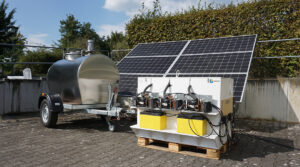
Launch of EEP Africa New Portfolio 2021
The new portfolio stems from a 2020 competitive call for proposals on Clean Energy Powering Green Growth. From among 357 applications submitted, 26 companies were awarded a total of EUR 8.3 million in financing for projects to be implemented in 12 countries across Southern and East Africa. The new grantees are mainly start-up companies (81%), with a significant share of locally-led (62%) and women-led (38%) enterprises.
We see many clean energy start-ups developing sustainable solutions to stimulate green growth in rural communities. However, it is a well-known fact that there is a severe lack of flexible and early-stage financing for such innovators, especially for local and women-led companies. EEP Africa is proud to be one of the leading funders willing to take risks and catalyse investment in new technologies and business models.
Small things that make a difference on your solar project
When planning a solar project, we all know how to think about PV panels, inverters and batteries. But there are many more elements that compose solar projects and which are often overlooked or not considered important.
When planning for a 25-year infrastructure project, all details and all components are however important if you wish for a smooth solar journey. In this webinar, we will shed light on the elements of solar projects which are often overlooked or totally forgotten, and yet which could make or break your project.
Join our speakers to learn more about:
- How the quality of DC and AC combiners is crucial for long-lasting solar projects while they represent only 2-3% of the overall project cost
- How IoT and remote monitoring is playing an increasingly important role in preventive maintenance and asset management of your solar projects
- The differences between mounting structures quality and the impact this may have in a 25-year period
During this webinar you will get great insights from the following panelists:
- Rajesh Rajan – Managing Director at Hensel Electric
- Edirin Aghoghovbia – Head of Business Development at AMMP Technologies
- Akram Abdelwhab – Group Technical Manager at British Approvals Service for Cables(BASEC)
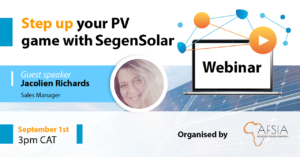
Easy project planning and sourcing with the SegenSolar Portal
Solar products and equipment keep evolving on a permanent basis and it is sometimes hard to keep track while developing projects and building new client relationships at the same time.
SegenSolar, as South Africa’s leading distributor of top solar brands, has created its Portal specifically to help solar installers gain time and money in the planning of their projects. With is unique Project Designer Tool, the SegenSolar Portal will help you build your entire BOQ in just a few clicks and see in real-time which products are in stock. And the Portal has many more cool features to help you with project planning and sourcing.
Join Jacolien in this online event during which we will:
– Present the interactive SegenSolar platform that solar installers can use as an extension of their project design and planning activities
– Discover how to obtain BOQs, quotation and other technical project documentation in just a few clicks
– Highlight key features of the SegenSolar Portal including live stock availability, live prices and many more
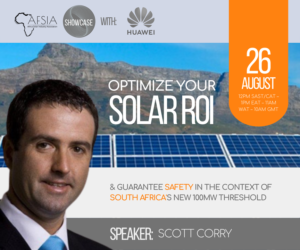
Optimize your solar ROI and guarantee safety in the context of South Africa's new 100MW threshold
The South African solar industry has experienced a crucial development a few weeks ago by having the legal capacity limit requiring a license moved from 1MW to 100MW. This has a monumental impact on the C&I segment, as many projects requiring more than 1MW of PV can now be developed without any fear of being stopped for licensing considerations.
As solar is increasingly gaining popularity in South Africa, a careful selection of equipment and planning is key to a successful project. Huawei Digital Power, a leader in driving the energy revolution by integrating digital and electronics technologies, is well-positioned to offer leading Smart PV solutions for utility-scale PV plants, commercial and industrial scenarios, and homes. Huawei FusionSolar Smart PV Solution features optimal electricity cost, active safety and free maintenance, helping generate higher energy yields and maximize investment returns.
During the webinar you will learn about:
– Commercial &Industrial PV in South Africa: Embedded generation threshold to increase to 100MW, challenges and opportunities
– Huawei’s Commercial & Industrial Smart PV solution: active safety, higher yields, and free maintenance
– Huawei’s Smart PV solution for utility-scale PV plants
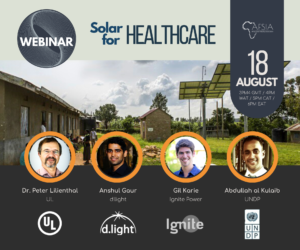
Solar for healthcare in Africa
14 months ago, many spotlights were turned towards the African healthcare sector and its terrible lack of electrification. Not being able to store and administer the COVID vaccine in Africa could deter all other global efforts in fighting the pandemic. Several programs were then launched to solve the issue of electrification at healthcare facilities and many experts had their opinion about what was the right way forward.
Fast-forward 14 months later, there are significantly less discussions and articles about electrifying the African healthcare infrastructure. But the problem persists and only a few healthcare facilities got access to electricity. Several emergency programs have disappeared as fast as they were announced and there still is an amazing work to be done to provide Africa with the most basic access to electricity and healthcare. But there are solutions, efficient, readily available and totally affordable! This webinar intends to highlight several initiatives and solutions which can significantly improve the access to electricity for the healthcare sector in Africa and deserve a lot more attention
In this webinar we will:
- discuss how it could actually take only $50M to electrify half of Africa’s healthcare facilities to address the 2 major pain points of rural doctors
- present a tool that helps public officials and solar professionals precisely size the required solar installation for any kind of healthcare facility depending on the medical equipment available and used
- present the new approach of international aid agencies to speed up healthcare electrification by adapting to and aligning with the needs of private solar companies across the continent
During this webinar you will get great insights from the following panelists:
- Peter Lilienthal, creator of HOMER and Global Microgrid Lead at UL
- Anshul Gaur, Director of Marketing & Grants at d.light
- Gil Karie, Director of Innovation at Ignite Power
- Abudullah Al Kulaib, Regional Specialist at UNDP’s Regional Bureau for Africa
This event will be of particular interest to:
- Government officials in charge of healthcare
- Health practicians
- Aid agencies
- African solar installers and developers
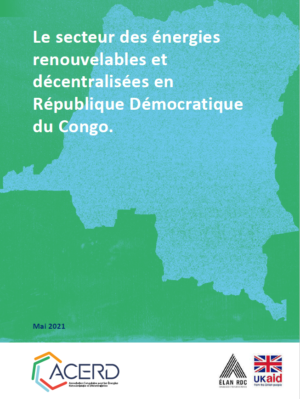
Le secteur des énergies renouvelables et décentralisées en République Démocratique du Congo.
L’étude entreprise par ACERD asbl constitue une première étude du secteur auprès de différents acteurs impliqués dans le domaine de l’accès à l’énergie par les énergies renouvelables décentralisées en RDC. Cette étude a analysé le secteur en termes de ménages, services communautaires et micro-entreprises connectés à une source d’énergie renouvelable décentralisée en fin 2020 ainsi que les prévisions pour 2021-2023 ; la hauteur des investissements réalisés ces dernières années et les prévisions d’investissements pour 2021-2023. Le but de cette étude ACERD asbl est de comprendre les défis et besoins des membres et de s’imprégner des expériences des autres pays africains et d’apporter des recommandations afin que l’ACERD asbl soit mieux outillée pour servir ses membres et le secteur en général.
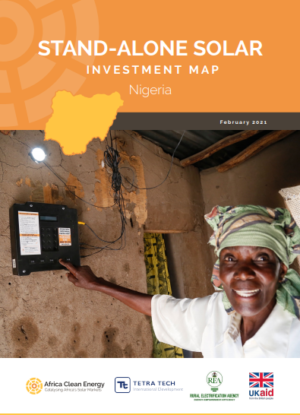
Stand - Alone Solar Investment Map Nigeria
The government of Nigeria currently targets 100 percent electrification rate by 2040, and off-grid energy will play a vital role. The electrification rate currently stands at 45 percent, with higher access in urban areas (55 percent) compared to rural areas (36 percent). While the country has an energy generating capacity of 12,522 MW, 20 million households remain without energy access. Extending on-grid connections will continue, but it will be timely and costly, particularly for rural and sparse populations. Off-grid energy, however, presents a viable alternative, and standalone systems are particularly well suited to reach the hardest to reach customers.
The SAS sector is nascent and fast-growing, and stakeholders have committed to its rapid expansion. The Nigerian government looks to add 5 million new solar connections through solar home system and mini-grids by 2023 under the 2020 Economic Sustainability Plan, reaching 25 million people.9 This builds on a young and growing sector, comprised of international companies that have established traction in other markets—for example BBOXX, Lumos, Zola Electric, d.light, Azuri, and Oolu—and often smaller but established local companies such as Sosai Renewables, Arnergy, Blue Camel, Consistent Energy, and ColdHubs, among others. Combined, these companies have an annual revenue potential of USD 1.2 billion, presenting opportunities for both private and public investments.
To achieve the government’s goals, stakeholders must execute a rapid roll-out and provide strategic support to existing SAS companies. Many companies in the sector are yet to achieve substantial scale-up of their businesses, and many—in particular local companies—cite limited access to the right financing as the primary setback to growth.
Given the capital-intensive nature of this sector, companies will require substantial investment to prove commercial viability, scale operations, and support the country’s electrification efforts.
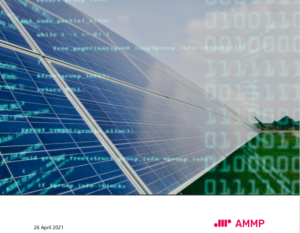
Putting energy data to work with pub/sub Going beyond REST APIs, and embracing the power of a new paradigm
Executive Summary
This paper explores the prevailing ways in which energy data is exchanged between parties – specifically in the context of data from PV and PV/hybrid systems. It lays out the most common established approaches, including “data push” and “data pull”, and discussed their respective advantages and shortcomings. The paper also presents the “publish/subscribe” (pub/sub) pattern of data exchange. While use of the pub/sub pattern is quite well
established in other industries, such as financial services and industrial IoT, it is still not widely used in the context of renewable energy data exchange. This paper presents the advantages of the pub/sub approach, as relating to this context.
In summary, pub/sub has a number of distinct advantages over established approaches. First and foremost, it allows for providers of data (e.g. devices in the field) to send real-time data and events. This can for example ensure that critical events are acted upon promptly.
It also provides a simple mechanism for eliminating gaps in historical data. Meanwhile, pub/sub allows for data consumers to subscribe to the specific data streams (“topics”) that are relevant to them. Overall, pub/sub protocols provide rich data interchange capabilities.
Meanwhile, they are straightforward to set up and maintain for both providers and consumers of data. Finally pub/sub protocols support best-practice security paradigms. In light of this, this paper presents the case for a comprehensive embrace of pub/sub data interchange across the renewable energy data ecosystem.
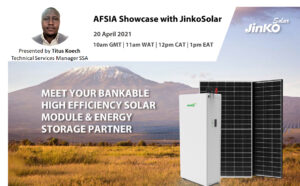
Meet your bankable high-efficiency solar module & energy storage partner
Join us for this Showcase event on High-Efficiency Module and Energy Storage Solution with Jinko Solar.
Many solar installers and developers have a habit of opting for low standard modules, sometimes with less guarantee.
But Jinko Solar technology innovation now makes it possible to get highest efficiency modules with a better control over costs, production and storage capacity from 50 kWh up to 1MWh.
Join us to learn and discuss:
• The importance of high-efficiency modules in Mini-Grid, Rooftop and C&I applications
• How solar energy storage will boost energy production over a given payback period
• How high-efficiency modules will help you reduce logistics costs
This event is open to all and will be of particular interest to MG developers and C&I installers and developers from Africa.
A big thank you to our speaker:
Titus Koech – Jinko Solar – Technical Service Engineer
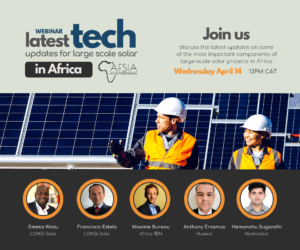
Latest tech updates for large-scale solar in Africa
Solar energy is now the world’s cheapest energy source. This is the result of the perpetual evolution of the solar industry and the relentless efforts of equipment manufacturers to permanently improve their solutions to optimize yield and reduce cost.
The last 24 months have witnessed a tremendous increase in the speed of innovations brought to market as well as drastic price shocks. In this webinar, we will discuss the latest updates on some of the most important components of large-scale solar projects in Africa and their impact on the competitiveness of solar in Africa for power generation at the utility level.
During this webinar, we will address:
• The pros and cons of high power solar modules
• The growing important role that storage plays in large-scale solar in Africa
• How inverters are becoming the brain of solar projects thanks to digital innovation
• The latest innovation in tracker design and operation to boost yield
In this webinar, our panelists will discuss both commercial and technical aspects to give the audience the most complete overview of the current status of large-scale solar projects. This webinar will serve as a great guide to developers, national utilities, and authorities on the latest trends in the solar industry and what to expect in the near future.
You may download the full presentation below or listen to the webinar again through our YouTube channel
A big thank you to our speakers:
Emeka Wosu – LONGi Solar – Global Business Development Manager
Francisco Estela – LONGi Solar – Technical Director of Global Development
Maxime Bureau – Africa REN – COO
Anthony Erasmus – Huawei – Advisory Account Manager
Hemanshu Sugandhi – Nextracker – Director Business Development
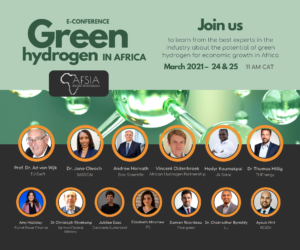
Green hydrogen potential for Africa
Hydrogen has been used for several decades by industrial companies because of its great convenience as fuel stock with regards to storage and transport. And thanks to the continued decreasing cost of renewables, the potential for green hydrogen is now growing exponentially and opening new avenues of use for hydrogen.
The success of green hydrogen will be linked to its production cost and Africa is ideally positioned to play a major role in this global industry as the continent enjoys some of the best renewable energy resources in the world.
But other factors may still prove challenging and could limit the extent to which Africa will benefit from this nascent industry.
In this e-conference, we will learn from the best experts in the industry about the potential of green hydrogen for economic growth in Africa.
During this virtual event we address the following:
• Specifying the fundamentals of green hydrogen and its advantages for the global economy
• Identifying the potential for green hydrogen production on the African continent
• Addressing the status of development of the green hydrogen ecosystem globally and in Africa
• Highlighting key success factors for rapid development and growth of a green hydrogen ecosystem in Africa
• Discussing current challenges faced by African countries to embark in green hydrogen production and proposing mitigation strategies
• Highlighting the role and impact green hydrogen can have on African nations
• Identifying the role of the solar industry in building a strong green hydrogen industry in Africa
Speakers include:
– Prof dr Ad van Wijk – TU Delft
– Dr Jane Olwoch – SASSCAL
– Dr Christoph Rövekamp – German Federal Ministry of Education & Research
– Dr Chakradhar Byreddy – UL
– Amy Halliday – Planet Power Finance
– Hadyr Koumakpai – JA Solar
– Jubilee Easo – Eversheds-Sutherland
– Elizabeth Minchew – IFC
– Damien Ricordeau – Finergreen
– Thomas Roos – CSIR
– Andrew Horvath – Star Scientific Group
– Ayoub Hirt – IRESEN
Moderated by:
– Dr Thomas Hillig – THEnergy
– Vincent Oldenbroek – African Hydrogen Partnership
Presentations:
DAY 1 – Keynote Speech – Prof. Ad van Wijk – TU Delft
DAY 2 – Keynote Speech – Vincent Oldenbroek – African Hydrogen Partnership
Report Rating : 4
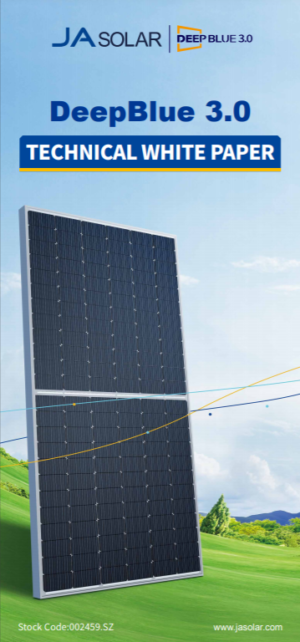
Technical White Paper of JA Solar DeepBlue 3.0
JA Solar has always taken technological innovation as its development founda tion, especially since the start of 2020, JA Solar has further increased its product R&D investment. By applying multiple technologies including M10 wafer (182mm size) technology, PERCIUM+ technology, multi-busbar (MBB) and half-cell technology, etc., JA Solar has launched its powerful product — Deep Blue 3.0, a high-efficiency and high-power PV module which brings customers a lower LCOE solution with the power of modules available for mass production up to 590W at the moment.
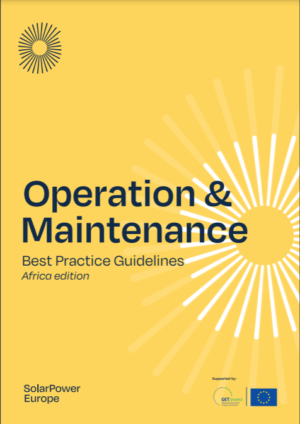
Launch of Operation and Maintenance Best Practice Guidelines: Africa edition
Building on Version 4.0 of SolarPower Europe’s O&M Best Practice Guidelines, this edition is adapted to the Sub-Saharan African context. It is a joint effort with ten African solar and renewable energy industry associations, from Ghana, Ivory Coast, Kenya, Mozambique, Nigeria, South Africa, Tanzania, Zambia, and Zimbabwe.
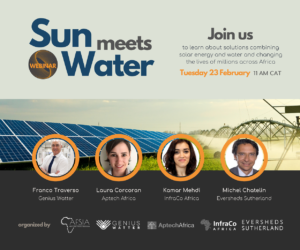
AFSIA webinar - Sun meets Water
Even more than access to electricity, access to (drinkable) water can be a challenge across Africa. Luckily, more and more ingenious technology is being developed to use existing water resources for irrigation or for human consumption.
These technologies are inextricably linked to solar as this often is the only way to power them.
In this webinar we will learn about solutions combining solar energy and water and changing the lives of millions across Africa.
During this webinar we will address
- How Genius Watter manages to deliver drinkable water in the most extreme environments thanks to solar energy
- How Aptech Africa plans to impact the agricultural output of Uganda by making irrigation affordable through its solar-powered PAY-N-PUMP solution for small-scale farmers
- Why solar is the most economical choice when it comes to irrigation and how investors such as InfraCo Africa are supporting developers to offer pre-financed solar irrigation solutions
- How floating solar could be a real game-changer in the African large-scale solar projects industry and legal and contractual aspects need to be considered for such projects
You may download the full presentation below or listen to the webinar again through our YouTube channel.
A big thank you to our speakers:
Franco Traverso – Genius Watter
Laura Corcoran – Aptech Africa
Kamar Mehdi – InfraCo Africa
Michel Chatelin – Eversheds-Sutherland
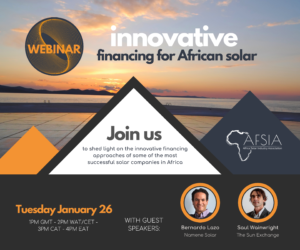
AFSIA webinar - Innovative financing for African solar
Financing can make or break a solar opportunity and it is key to have knowledge of and access to the appropriate sources of financing to be successful in this industry.
But some companies are more creative than others and have pushed the thinking of novel financing approaches for different segments of the solar industry.
In this webinar which took place on 26 January 2021, we shed light on the innovative financing approaches of some of the most successful solar companies in Africa. Our 2 guest companies are truly different in the way they address financing of their respective business activities and this is probably one key element of their ongoing success.
During this webinar we addressed
- The impact of carbon credits to finance the pico-solar industry (Namene Solar)
- How crowdfunding and block-chain technology can combine to create one of the most powerful C&I financing mechanism in South Africa (The Sun Exchange)
You may download the full presentation below or listen to the webinar again through our YouTube channel.
A big thank you to our speakers:
Bernardo Lazo – Namene Solar
Saul Wainwright – The Sun Exchange
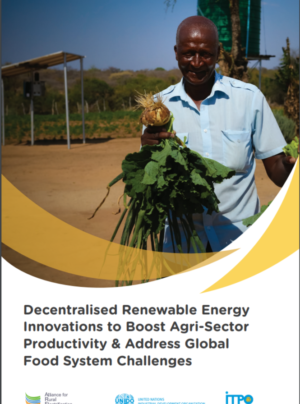
Decentralized RE innovations to boost agri-sector productivity
Zero hunger can be achieved by providing energy beneficiaries with the means to produce, transform and consume food in a clean and sustainable way, thereby enhancing both their food security and nutrition.
Agriculture is a source of livelihood for 86% of people living in rural areas globally. Besides farming, livelihoods can encompass various activities in other key agricultural sub-sectors, including livestock and fishing and aquaculture.
The Organisation for Economic Co-operation and Development (OECD) highlights three major challenges faced by the global food system:
- Feeding a growing population
- Providing a livelihood for farmers
- Environmental protection
There is a strong need for increased adoption of sustainable agricultural practices to bring the food from farm to fork while addressing the above three challenges. This is where decentralised renewable energy (DRE) technologies can and must play a key role. Moreover, as innovation in DRE-powered agricultural equipment and appliances steam ahead, their technical and commercial viability will improve further.
Based on best practices from the 15 case studies included in this publication and general observations, ARE and UNIDO ITPO Germany developed recommendations for public and private stakeholders working in the field to boost DRE uptake to power agricultural productivity.
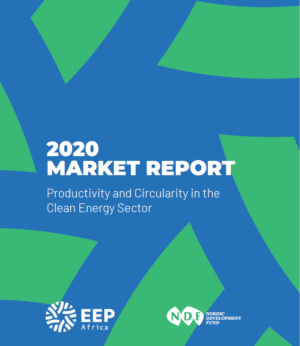
EEP Africa - Productivity and Circularity in the Clean Energy Sector
A new report exploring recent developments in the clean energy market in Southern and East Africa based on insights from EEP Africa’s support for early-stage, private sector-led projects.
In its 2020 Market Report, EEP Africa uses data collected from our call for proposals, annual survey and active portfolio to look at three rapidly developing areas of the clean energy market:
- Evolution of productive use of energy (PUE)
- Role of clean energy in a circular economy
- Impact of COVID-19 on early-stage companies
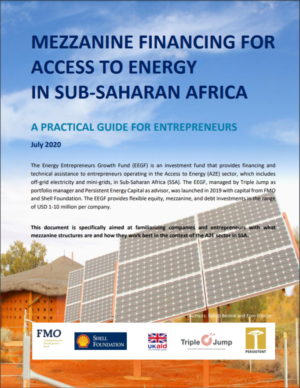
Practical Guide to Mezzanine Financing for Access To Energy in Sub-Saharan Africa
This document is specifically aimed at familiarizing companies and entrepreneurs with what mezzanine structures are and how they work best in the context of the A2E sector in SSA.
The Energy Entrepreneurs Growth Fund (EEGF) is an investment fund that provides financing and technical assistance to entrepreneurs operating in the Access to Energy (A2E) sector, which includes off-grid electricity and mini-grids, in Sub-Saharan Africa (SSA). The EEGF, managed by Triple Jump as portfolio manager and Persistent Energy Capital as advisor, was launched in 2019 with capital from FMO and Shell Foundation. The EEGF provides flexible equity, mezzanine, and debt investments in the range of USD 1-10 million per company.
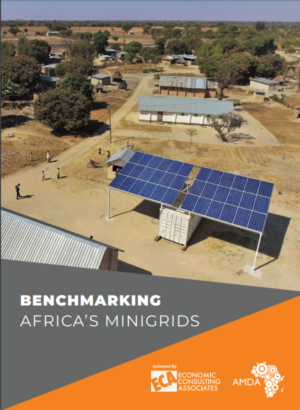
AMDA Africa Mini-Grid Benchmark 2020
With this report, the Africa Minigrid Developers Association (AMDA) is opening the door to a new era in the
minigrid sector. One of continental transparency in performance, cost, and scale information that will allow
decision-makers in national governments, donor institutions, and investors to make more informed choices
than ever before. And it will help minigrid companies understand how they are performing vis-à-vis their peers
for the first time as well.
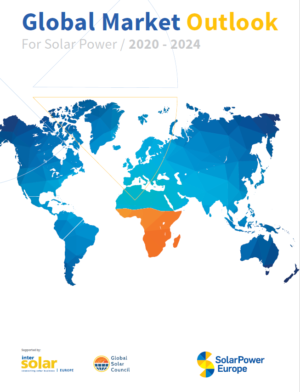
Global Market Outlook For Solar Power / 2020 - 2024 by SolarPower Europe
Released on 16 June 2020
The return of the global solar market to two-digit growth rates in 2019 signaled a positive trajectory for the sector.
But in 2020, the solar world looks very different: the COVID-19 pandemic has not spared the solar power sector.
This year, new solar grid connections are expected to drop the first time in many years. Now it is of utmost
importance that governments do not disregard renewables and solar power when developing economic stimulus
packages. If the world is serious about meeting the Paris Agreement climate targets, solar deployments not only
need to get back on their recent growth track, but the installation rate of solar, the lowest-cost and most versatile
power generation technology, must increase much faster, in the short- and mid-term.
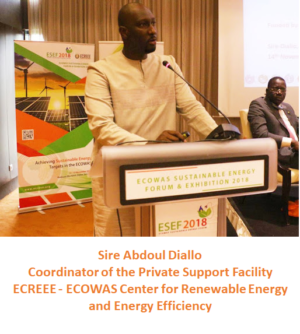
Sustainable Energy Access during COVID-19: Time for Collaboration not Heroes
Released on 8 June 2020
In the wake of this pandemic, the role of sustainable energy solutions has come to the forefront with many governments declaring energy an essential service. Now more than ever, it is clear that access to sustainable energy is essential, especially, in regards to building a robust response and recovery to the COVID-19 pandemic.
The sustainable energy sector has been prone to respond positively and quickly. But one must recognize that, with a few notable exceptions, this has mostly taken place in a poorly coordinated way.
In this Op-Ed, the author lists several recommendations as a crying call for the sustainable energy market ecosystem to efficiently support the global response to and recovery from the COVID-19 pandemic in efficient and sound manner.
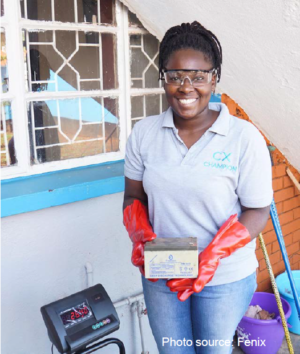
Solar e-waste management innovations in sub-Saharan Africa
Released on 26 May 2020
The global market for off-grid solar technologies is growing rapidly. Investments in e-waste management are needed now to ensure that the sector grows sustainably and remains a leader in environmental responsibility. Off-grid industry leaders are exploring e-waste management solutions, such as product repair initiatives and preventative maintenance, as well as the role of waste reduction in the initial product design stage.
In this report you can expect to learn about initiatives that:
• Streamline and integrate take-back & collection into company business models
• Facilitate product refurbishment, reuse, or repurposing
• Create partnerships with the informal sector
• Enhance consumer awareness around proper e-waste disposal
• Develop second-life battery initiatives
• Extend product and/or component lifespan; and
• Enhance product reparability and recyclability
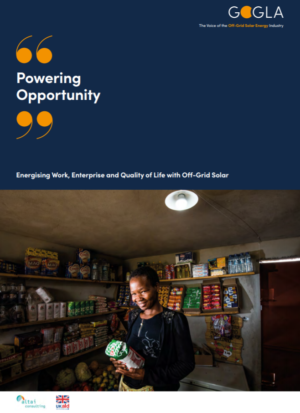
Powering Opportunity: Energising Work, Enterprise and Quality of Life with Off-Grid Solar
Released in May 2020
As the world responds to the COVID-19 pandemic, we now have more evidence than ever that off-grid solar is a power tool for change, helping to build resilience on the road towards a sustainable economic recovery.
Following 2018’s ground-breaking Powering Opportunity report, GOGLA expanded the research on the impact of solar home systems to more regions, including South Asia and West Africa. For East Africa, GOGLA went back to the households of the 2018 research to find out about the long-term effect of solar home systems.
The research confirms that people with solar home systems gain more income and work longer hours while feeling safer and healthier and provides some appalling statistics about the positive impact of SHS on people’s lives.
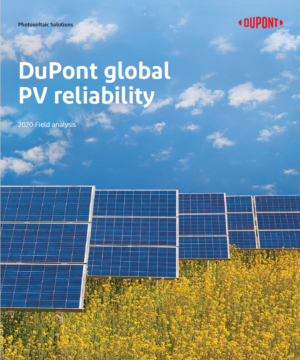
2020 Global Photovoltaic Reliability Report by DuPont
Released in May 2020
DuPont runs a unique program featuring a multi-step inspection protocol conducted by DuPont scientists and engineers in North America, Europe, Asia and the Middle East. The 2020 field report was compiled from inspection and analysis of nearly 3 gigawatts (GW) of photovoltaic (PV) installations around the globe, spanning 9 million panels. A number of variables were analyzed in the course of the inspections including component, material, mounting, time in service and climate.
Key findings (compared to 2019):
Total module defects:30 percent
Total backsheet defects:16 percent
The overall outer layer cracking rate of polyvinylidene fluoride (PVDF) backsheets increased by more than three times
Emerging trends in backsheet failures include:
Rapid increase in cracking in PVDF backsheets
Cracking of inner layers
Delamination in double glass modules.
Read the full research and results in the complete Global PV Reliability Report.
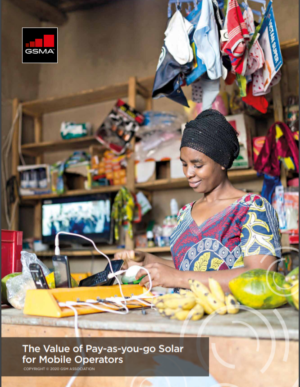
The value of PAYG solar for mobile operators
Released in May 2020
The PAYG solar and telecom industry in Africa have been inextricably related since 2012.
This report provides the first multi-country analysis to quantify the value of that synergy for the mobile industry.
Five mobile operators from Uganda, Rwanda, Benin, Côte d’Ivoire, and Zambia worked with GSMA to provide aggregated and anonymised mobile money and GSM data in order to measure the commercial value that the PAYG solar industry has for the mobile industry.
The key findings from this analysis are as follows:
– PAYG solar customers show significantly increased mobile money usage, beyond just solar payments
– PAYG solar drives adoption of mobile money
– PAYG solar customers yield increased overall revenue for mobile operators
– PAYG solar demonstrates the case for strengthening and broadening collaboration

International players mobilize to support the African solar industry through challenging times
Released on 6 May 2020
While many countries around the globe are making their first steps into deconfinement, many specialists are already warning about the financial aftermath of the pandemic and the potential economic tsunami on the global economy.
In an effort to proactively support the nascent African solar industry, several organizations have been working on dedicated mechanisms to bring entrepreneurs and SMEs the necessary funds and support to pass through this difficult period. Below is a list of the most notable initiatives that are currently available
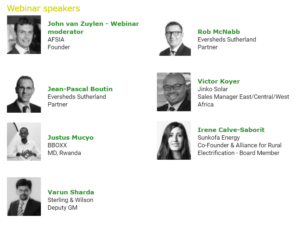
AFSIA webinar: COVID-19 implications on African solar industry
On April 17, AFSIA co-hosted a webinar with Eversheds-Sutherland to discuss the implications of the COVID pandemic on the African solar industry.
Panelists included:
Irene Calve-Saborit – Sunkofa Energy – Co-Founder & Alliance for Rural Electrification – Board Member
Justus Mucyo – BBOXX – MD Rwanda
Victor Koyer – Jinko Solar – Sales Manager East/Central/West Africa
Varun Sharda – Sterling & Wilson – Deputy GM – Solar
Jean-Pascal Boutin – Eversheds-Sutherland – Partner
Rob McNabb – Eversheds-Sutherland – Partner
Relisten to the webinar here
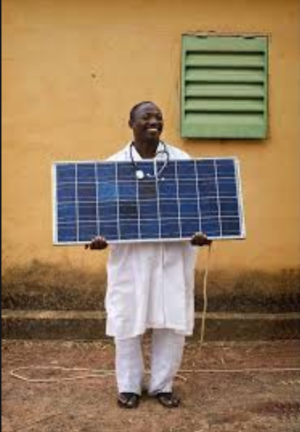
The time is now for solar at African health centers
We are still in the midst of the crisis but today I wanted to take a positive angle and look at the future. Researchers are now working day and night to develop a cure and eventually a vaccine. And it is reasonable to expect this vaccine will be available in the medium term. The virus knows no border and in order to be efficient it will need to be available globally, even in the most remote parts of Africa. This may be challenging as vaccines require to be refrigerated and the WHO estimates that only 28% of African health centers have access to reliable energy.
Solar has demonstrated it can be a quick and cost-effective solution to power remote health centers.
Now is a better time than ever to focus efforts on solar for minimum universal health care across Africa.
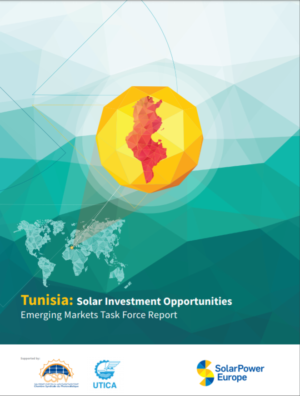
Tunisian Solar Investment Opportunities by SolarPower Europe
Released in February 2020
The report provides a snapshot of Tunisia’s business environment, macroeconomic trends, and issues related to the country’s credit and political risk.
This new report shows that Tunisia has strong solar potential, which the government is increasingly harnessing. However, in order to effectively take advantage of this opportunity, the report issues a series of recommendations for investors, policymakers, and local stakeholders.
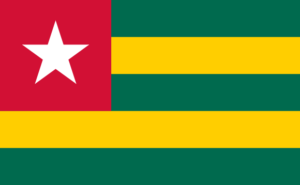
The rise and rise of solar in Togo
Togo is a small country in West Africa that seldom makes the headlines of international news. But when it comes to solar, this country really stands out as amazing example for the promotion of solar as a solution to develop the country and bring cheap and reliable electricity to its population.
What is truly peculiar about Togo is not so much the absolute size of the different solar initiatives that are under way (the population amounts to only 8 million residents, not to be compared with the almost 200 million neighboring Nigerians). The most noteworthy aspect of solar in Togo is the wide diversity of solar initiatives currently being deployed across the country. The Government of Togo (GoT) has engaged into an aggressive program to provide solar through a multitude of solutions, adapted to the specific needs across the country.
You may download the status list of all initiatives under way as of February 2020 below.
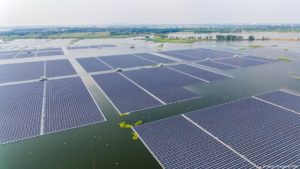
Will Africa follow suit on Asia’s upbeat plans to develop floating solar across the continent?
In January 2020, floating solar in Africa came into the global spotlights with the announcement of the winning bidder for the 4 MWAC floating PV system to be built on Le Rocher lagoon in Mahé in Seychelles. This IPP project is a notable achievement for the continent and for the entire world as it pushes further both technical and commercial boundaries.
In this paper, Celine Paton, Senior Financial Analyst at SERIS, the Solar Energy Research Institute of Singapore, and expert on floating solar globally shares with us insights on the global market of FPV, the drivers and benefits of this new segment of the solar industry, and why this is a technology we should all keep a close look at.
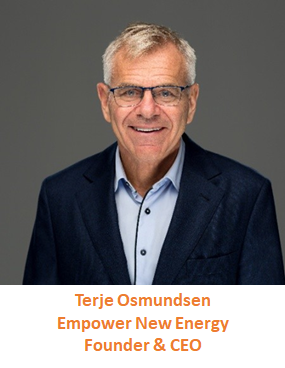
MEMBER'S VIEWS - WHAT DOES IT TAKE TO ELIMINATE ENERGY POVERTY IN AFRICA?
Terje Osmundsen provides key to answering this question through an analysis of the recently published EIA Africa Energy Outlook 2019 and based on his findings and discussions on the ground at the latest energy conference in Lagos, Nigeria in November.
Despite a burgeoning renewable energy industry across Africa, and numerous projects of all sizes becoming operational, gas will inevitably remain an important component of the Africa’s energy mix in the future. And somewhat surprisingly, coal keeps rising.
This article was first published on the Energi og Klima website on 17 November 2019 and can be read here.
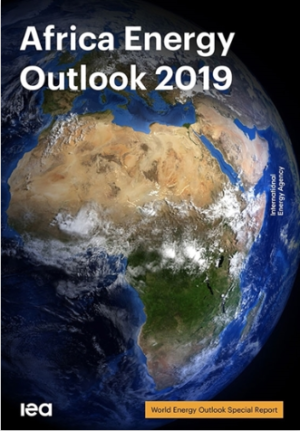
EIA AFRICA ENERGY OUTLOOK 2019
Released on 8 November 2019
Rapid economic and population growth in Africa, particularly in the continent’s burgeoning cities, will have profound implications for the energy sector, both regionally and globally. The stage is set for a new wave of dynamism among African policy makers and business communities, with falling costs of key renewable technologies opening up new avenues for innovation and growth. Chief among the challenges is providing universal access to reliable, modern, affordable and sustainable energy. How to do this is a crucial component of Africa’s Agenda 2063 strategic framework for the continent’s future and of global Sustainable Development Goals. Realising the potential of the continent’s natural gas and mineral resources presents another key challenge.
Five years after the World Energy Outlook’s first special report on Africa, the International Energy Agency has updated and expanded its outlook for the continent based on in-depth, data-rich and country-specific analysis. This new report provides important policy insights to help African energy stakeholders achieve the continent’s growth ambitions in a sustainable and inclusive manner. It also explores how the rise of consumerism in Africa might affect global trends.
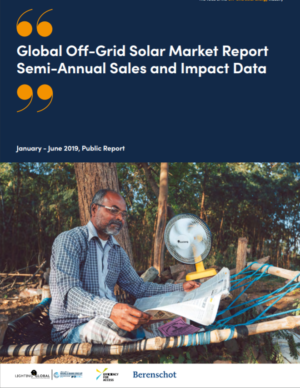
GLOBAL OFF-GRID SOLAR MARKET REPORT 2019 (Sales and Impact Data)
Released on 30 October 2019
Read the latest report on off-grid solar sales and impact data. Every six months, GOGLA and The World Bank Group’s Lighting Global program publish the Global Off-Grid Solar Market Report, a market intelligence series on sales and impact of off-grid solar lighting products, sold by GOGLA and Lighting Global affiliates. Since 2019, the report also includes sales numbers of off-grid appliances, in partnership with the Efficiency for Access Coalition.
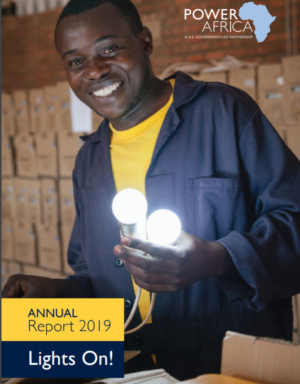
POWER AFRICA ANNUAL REPORT 2019
Released on 22 October 2019
Since 2014, Power Africa is making a difference across all sectors, from health and education to gender and agriculture. As of July 31, 2019, 56 of Power Africa’s 124 financially closed projects are up and running and turning more Lights On by producing 3,486 MW of new electricity that transforms businesses, economies, and livelihoods. More than 68 million people in sub-Saharan Africa now have first-time access to electricity thanks to the 14.8 million new home and business connections facilitated by Power Africa support.
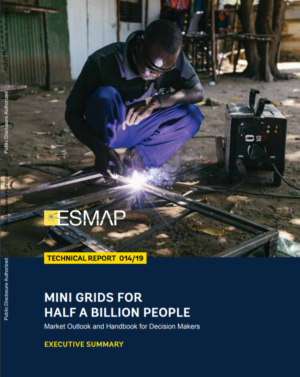
Mini Grids for half a billion people
Approximately 1.2 billion people will need to gain access to electricity to achieve universal access by 2030. The only way to achieve this is through a combination of the main grid extension, mini grids, and off-grid solar.
This report shows that about half a billion people can be cost-effectively provided with electricity through mini grids. The combination of falling costs, dramatic increase in the quality of service, and favorable enabling environments have made modern mini grids a scalable option to complement grid extension and solar home systems.
The report is the most comprehensive study on mini grids to date.

INTERSOLAR SOLARIZE AFRICA MARKET REPORT
Released on 13 May 2019
The report is covering ten key markets on the African continent as well as trends, opportunities and business models. It is also claiming that the continent’s PV market could expand from about 5 GW at present to up to 30 GW by the end of the next decade.
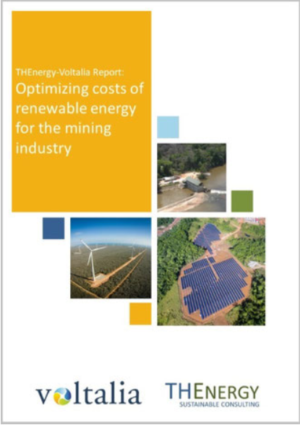
OPTIMIZING COSTS OF RENEWABLE ENERGY FOR THE MINING INDUSTRY
Released on 1 February 2019
The report shows that there is considerable cost reduction potential that comes from a variety of different factors. The following graph gives an overview of the main factors that contribute to optimizing costs for hybrid power plants and that enable IPPs to offer the best price PPAs to mining companies.
Download the report here
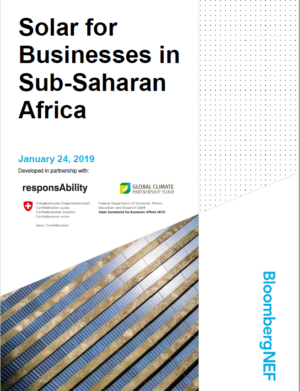
BNEF SOLAR FOR BUSINESSES IN SUB-SAHARAN AFRICA
Released on 24 January 2019
This research has been commissioned by responsibility to assess the potential and target markets for C&I solar in Sub-Saharan Africa. BloombergNEF undertook a desk-based regional study to identify three high priority markets (Kenya, Nigeria, and Ghana) that were later studied in more detail. There, BNEF conducted interviews with 36 stakeholders in those markets.
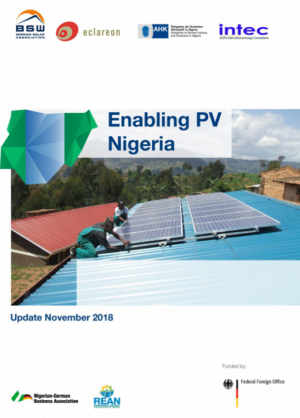
ENABLING PV IN NIGERIA
Released on 1 November 2018
In this study the German Solar Association (BSW-Solar) in cooperation with eclareon GmbH, the GOPA-International Energy Consultants GmbH (GOPA Intec), and the Delegation of German Industry and Commerce in Nigeria (AHK Nigeria), analyse and describe the process of investment and project development of PV power plants in Nigeria. This includes the description of the legal and administrative framework and of import, trade and investment conditions, as well as the presentation of selected business cases.
Download the report here

AFRICA SOLAR IMPACT CASES
Released on 15 October 2018
The aim of this document is to zoom in on individual solar projects and cases, highlighting the involvement of the different types of actors in the creation of resounding impact on local communities and individuals. To go beyond the numbers and – through the stories and experiences of lesser-heard voices – showcase the significance of solar energy development. To do that, we have selected a small number of cases across the three segments to paint a human picture of the evolving solar energy markets of Africa.
Download the report here
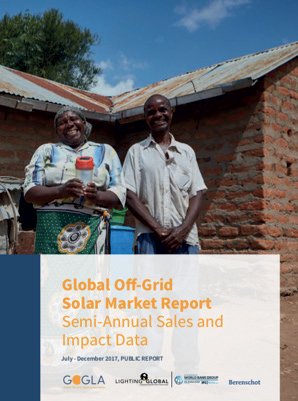
GLOBAL OFF-GRID SOLAR MARKET REPORT H2 2017 (SALES AND IMPACT DATA)
Released on 26 April 2018
This GOGLA and The World Bank Group’s Lighting Global report includes sales and impact data from 67 off-grid solar companies covering the period of July to December 2017.
Download the report here
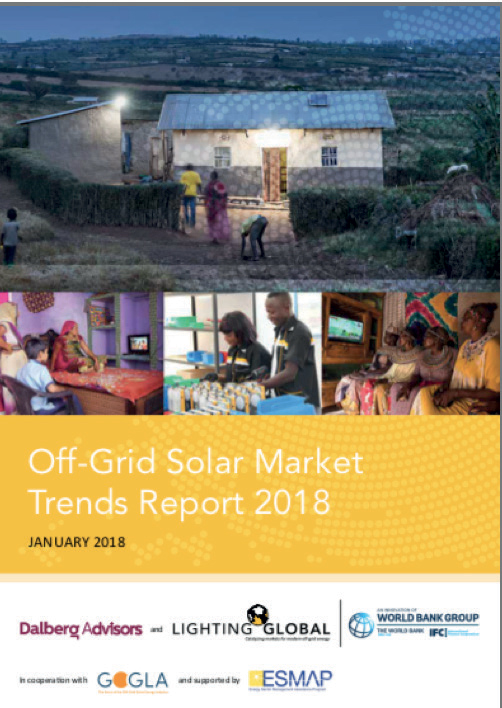
2018 OFF-GRID SOLAR MARKET TRENDS REPORT
Released on 28 January 2018
In 2017, the global off-grid solar (OGS) sector is providing improved electricity access to an estimated 73 million households, or over 360 million people, thus transforming lives that were previously reliant on kerosene and solid fuels for most of their lighting needs.
This market has evolved and expanded substantially since 2010, when IFC released its first off-grid lighting report.
At that stage this was a market marked by low awareness, a single category of lighting-oriented products, and a limited geographical presence (mainly in Sub-Saharan Africa and India).
Download the report here
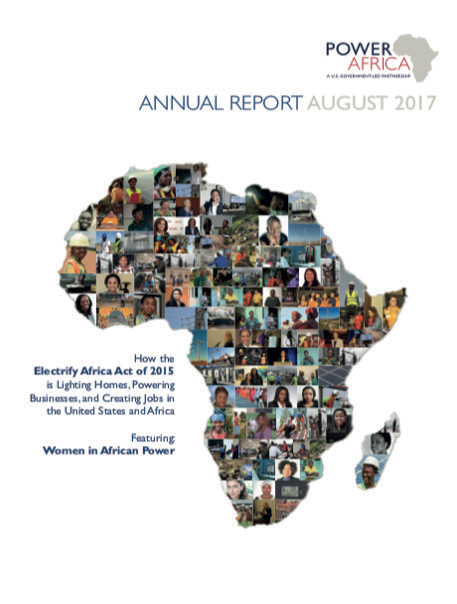
POWER AFRICA USAID ANNUAL REPORT 2017
Released in October 2017
Since 2014, Power Africa has supported 117 transactions that have reached financial close. Those 117 transactions will generate over 9,500 megawatts (MW) of new, more reliable electricity. More than 57 million people in sub-Saharan Africa now have access to electricity that did not prior to 2014, thanks to the 12.5 million new home and business connections facilitated by Power Africa support.
The Power Africa 2018 Annual Report also looks to the future, and explains how Power Africa will continue to add generation capacity and connections, but will further look to enhance transmission and distribution resources, improving government capacities to manage their power sectors, and leveling the playing field for competitive investment.
Download this report and previous annual reports here
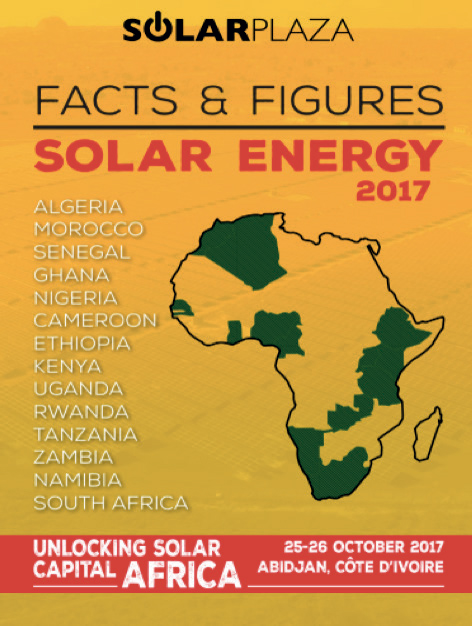
FACTS & FIGURES: SOLAR ENERGY 2017
Released on 4 August 2017
Africa is quickly becoming one of the most significant regions in the global expansion of the solar PV industry. The high levels of solar irradiation, extreme (and growing) energy demand, an increasing amount of renewable energy related commitments by governments in the region, and the lack of reliable energy infrastructure are just some of the factors that are sparking growing interest from local businesses and international stakeholders alike.
The purpose of this report is to provide an overview of the key facts and figures related to some of the most prominently developing solar markets on the continent, serving as well as a prelude to the Unlocking Solar Capital: Africa conference Solarplaza will be organizing together with GOGLA, on 25 and 26 October 2017 in Abidjan, Côte d’Ivoire.
Download the report here.
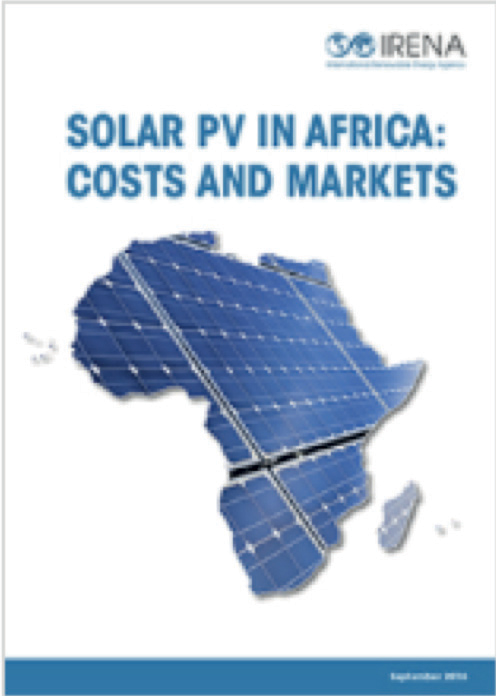
SOLAR PV IN AFRICA: COST AND MARKET
Released in September 2016
Africa has abundant renewable energy resources. Traditionally reliant on hydropower, the continent is turning to solar photovoltaics (PV) to bolster energy security and support rapid economic growth in a sustainable manner. With recent substantial cost reductions, solar PV offers a rapid, cost-effective way to provide utility-scale electricity for the grid and modern energy services to the approximately 600 million Africans who lack electricity access.
According to this report, installed costs for power generated by utility-scale solar PV projects in Africa have decreased as much as 61 per cent since 2012 to as low as USD 1.30 per watt in Africa, compared to the global average of USD 1.80 per watt. The report shows that mini-grids utilising solar PV and off-grid solar home systems also provide higher quality energy services at the same or lower costs than the alternatives. Stand-alone solar PV mini-grids have installed costs in Africa as low as USD 1.90 per watt for systems larger than 200 kilowatt. Solar home systems provide the annual electricity needs of off-grid households for as little as USD 56 per year, less than the average price for poor-quality energy services.
IRENA estimates that with the right enabling policies, Africa could be home to more than 70 gigawatts of solar PV capacity by 2030. The report discusses challenges in policy making and proposes a coordinated effort to collect data on the installed costs of solar PV in Africa, across all market segments. Such information will improve the efficiency of policy support and accelerate deployment.
Download the report here


